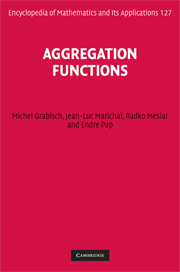Book contents
- Frontmatter
- Contents
- List of figures
- List of tables
- Preface
- 1 Introduction
- 2 Properties for aggregation
- 3 Conjunctive and disjunctive aggregation functions
- 4 Means and averages
- 5 Aggregation functions based on nonadditive integrals
- 6 Construction methods
- 7 Aggregation on specific scale types
- 8 Aggregation on ordinal scales
- 9 Aggregation on bipolar scales
- 10 Behavioral analysis of aggregation functions
- 11 Identification of aggregation functions
- Appendix A Aggregation of infinitely many arguments
- Appendix B Examples and applications
- List of symbols
- References
- Index
6 - Construction methods
Published online by Cambridge University Press: 05 March 2013
- Frontmatter
- Contents
- List of figures
- List of tables
- Preface
- 1 Introduction
- 2 Properties for aggregation
- 3 Conjunctive and disjunctive aggregation functions
- 4 Means and averages
- 5 Aggregation functions based on nonadditive integrals
- 6 Construction methods
- 7 Aggregation on specific scale types
- 8 Aggregation on ordinal scales
- 9 Aggregation on bipolar scales
- 10 Behavioral analysis of aggregation functions
- 11 Identification of aggregation functions
- Appendix A Aggregation of infinitely many arguments
- Appendix B Examples and applications
- List of symbols
- References
- Index
Summary
Introduction
There is a well-known demand for an ample variety of aggregation functions having predictable and tailored properties to be used in modeling processes. Several construction methods have been introduced and developed for extending the known classes of aggregation functions (defined either on [0, 1] or, possibly, on some other domains). Obviously, new construction methods should be a central issue in the rapidly developing field of aggregation functions. In this chapter we present some well-established construction methods as well as some new ones.
The first group of construction methods can be characterized “from simple to complex”. They are based on standard arithmetical operations on the real line and fixed real functions. The second group of construction methods starts from given aggregation functions to construct new ones. Here we can start either from aggregation functions with a fixed number of inputs (e.g., from binary functions only) or from extended aggregation functions. Observe that some methods presented are applicable to all aggregation functions (for example, transformation), while some of them can be applied only to specific cases. Finally, there are construction methods allowing us to find aggregation functions when only some partial knowledge about them is available. These extension methods are discussed in the last two sections of this chapter.
Transformed aggregation functions
The idea of transformation of aggregation functions can be clearly illustrated on the well-known relation of the two basic arithmetic operations of addition and multiplication.
Information
- Type
- Chapter
- Information
- Aggregation Functions , pp. 234 - 271Publisher: Cambridge University PressPrint publication year: 2009
